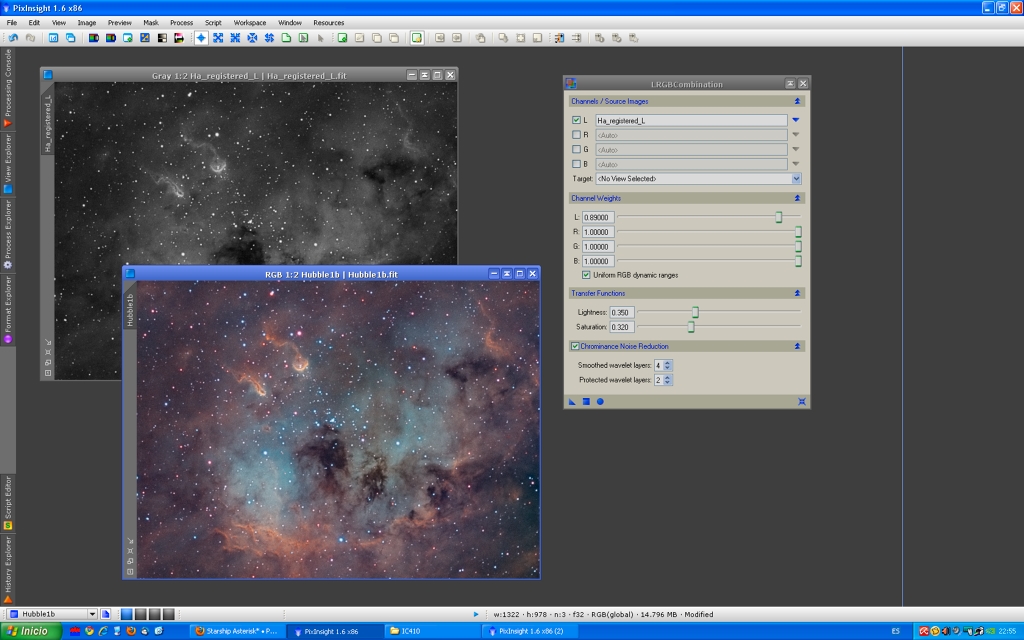
| |
| IC410 - NGC1893 - SHO color
|
|
Auriga
Faint Ha nebulosity surrounding the open star cluster NGC 1893 |
|
| |
Awards & publications:
Published in AstronomiA magazine, No.144, Jun. 2011
|
|
| |
IC410 lies about 12,000 light-years away in the northern constellation Auriga.
The cloud of glowing gas is over 100 light-years across, sculpted by
stellar winds and radiation from embedded and rather small open star cluster NGC 1893.
The radiation from these hot stars pushes the gas away from them and
creates the darker hole like features. The
"tadpoles" are regions of denser, cooler gas.
These resist the erosive radiation from
the hot stars. The high radiation slowly eats away and
the matter streams away from the stars creating the tails seen in the
image. Potentially sites of ongoing star formation.
This is a false color image using Hubble Palette, created from three narrowband filters: Ha, S2 and OIII.
(text extracted from Internet)

IC410
se encuentra a unos 12.000 años luz de distancia en la constelación de
Auriga. La nube de gas resplandeciente tiene más de 100 años luz de
diámetro, y es esculpida por los vientos estelares y la radiación del relativamente pequeño cúmulo abierto NGC1893.
La
radiación de estas estrellas calientes empuja el gas lejos de ellos y
crea agujeros y formas en el gas. Los "Renacuajos" son regiones más
densas y frías de gas. Estos resisten la erosión de la radiación de las
estrellas que poco a poco se come y lanza la materia desde las
estrellas, creando las colas de los "renacuajos" de unos 10 años luz de
largo que se ven en la imágen. Estos son lugares potenciales de creación
de nuevas estrellas.
Esta es una imagen en falso color en Paleta Hubble, creada a partir de tres filtros de banda estrecha Ha, SII, OIII.
PROCESING DETAILS:
The full process details for this picture are as follows:
1.-
Captured using standard methods and techniques. Three days narroband
images, Ha (Baader 7nm), OIII and S2 (Baader 8nm). Note: some days later
I discovered my f/4 telescope was out of collimation during these shots
(!).
2.- Separate calibration, registration and integration of each
set of shots using PixInsight Core 1.6. Standard masked histogram
stretch for the resulting three images. All further process was done
with PixInsight Core 1.6.
3.- PixelMath using the following formula (from PixInsight forums):R = 0.5*S2 + 0.5*Ha ; G = 0.15*Ha + 0.85*O3 ; B = O3
4.- Masked curves adjustment.
5.-
High Dynamic Range Wavelet Transformation (HDRW) on 2 layers over a
copy of Ha image obtained in step 2. ACDNR masked noise reduction
applied. Masked Morphological Transformation (erosion), applied only to
stars to reduce its size.
6.-
LRGBCombination, using the modified Ha image obtained in step 5 as
Luminance at about 90%, and narrowband color combination obtained in
step 4 as chrominance. Chrominance noise reduction applied. Lighness and
saturation slightly adjusted.
7.- Masked curves adjustment and ACDNR final masked noise reduction applied.
This
is not a silver bullet nor is expected to be a perfect processing
technique, but it's what I did and hope this help to anyone to give a
try on their narowband shots.
|
|
| |
| Technical details: |
|
Location: |
Valdemorillo - Spain |
Date: |
04/02/2011 (dd/mm/yyyy) |
Conditions: |
Good |
Temperature: |
ºC |
Humidity: |
|
|
|
Telescope: |
GSO Reflector 200mm f/4
|
Reducer/corrector: |
Baader MPCC
|
Filter: |
Baader OIII 8nm, SII 8nm, Ha 7nm combination 2"
|
Mount: |
Orion Atlas EQG
|
Camera: |
Atik 314L+
|
Exposure: |
21x300s Ha, 30x300s OIII, 15x300s SII, T-10 |
Guiding tube: |
B&C 60/350 f7
|
Guiding camera: |
Meade DSI Pro
|
Guiding software: |
PHD Guiding
|
|
|
Procesing: |
No dark. Calibrated, registered and integrated with PixInsight.
Processed with PixInsight.
PixelMath to create Hubble Pallete with Ha, OIII and SII.
LRGB combination using Ha. ACDNR. |
|
Notes: |
R=0.5*S2 + 0.5*Ha
G=0.15*Ha + 0.85*O3
B=O3
LRGB=0.84L(Ha, HDRW 2), 0.36 Lightness, 0.39 saturation. Chroma NR. 22/jan, 25/jan, 4/feb |
|
| |
|
|
|
|




